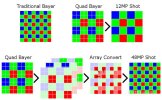Occams Razor
Well-Known Member
Can you let us know where you saw that the Air 3 has a BSI sensor? The Air 3 may have a stacked sensor but I believe it is the same sensor generation as those found in the Mini 3P/4P and MP3 (medium telephoto) because there is nothing in the specs that indicate that the Air 3 has a greater readout speed than any of those other sensors. Also DJI does not state anything about BSI or stacked sensors in the Air 3 specs which I would think they would want to promote given that these technologies are typically found in the high-end MILC's.My apologies but this is just untrue. Although a slightly smaller physical sensor (1” vs 0.77”), the Air 3 uses a state-of-the-art stacked and backside illuminated sensor, which can gather a ton more light than standard sensors of the past, which stacks the individual components in separate wafers to dramatically increase sensor read speed, and which has 48 physical megapixels that are pixel-binned (4 pixels become 1 huge pixel) to 12MP using a QuadBayer design when recording video and when in 12MP photo mode. In every measurable way, the Air 3 sensor performs better than the Air 2S, especially with regards to noise and the speed of the sensor due to the stacked design. One only has to shoot video at night to see the clear difference in the quality. Sensor size is only one variable when it comes to overall picture quality, there are many, many other variables.
View attachment 173235
Example of stacked sensor, showing separation of components into individual wafers that are then stacked together.
View attachment 173236
Differences between a regular (FSI) sensor and a BSI sensor, which the Air 3 uses. The main difference is all the electrical wiring is now underneath the photodiodes as opposed to above them, so they are no longer blocking any light from reaching the photodiodes, allowing the sensor to receive dramatically more light than it could before. BSI sensors can receive a similar amount of total light as much bigger sized FSI sensors, which the Air 2S uses.
These two huge physical upgrades to the sensor combine to make the Air 3 sensor an incredible piece of technology and a huge upgrade to the Air 2
I do agree that the Air 3 potentially has better low light performance as compared to the Air 2S but this is primarily due to the Air 3's f/1.7 lens while the Air 2S has a slower f/2.8 lens - this is 1-1/2 stops of increased light which will make a visible difference in image quality.
Last edited:











